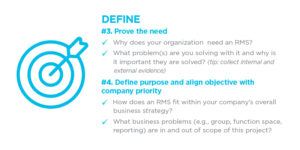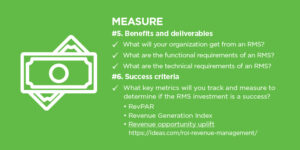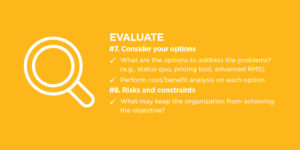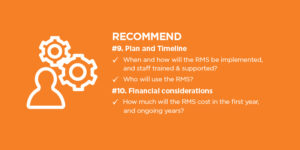If you’re looking to make a business case for a revenue management system (RMS), you’re making a smart decision.
After all, organizations that switch to an RMS experience a 7 to 20% increase in revenue per available room (RevPAR) plus an average 2 to 7% increase in profit margin (Deloitte, Pricing Analytics: The three-minute guide, 2012) (Hotel Tech Report, What is a Revenue Management System?, 2022). Additionally, their revenue managers save about 20 to 40 hours per month. And those aren’t the only benefits (Hotel Tech Report).
But while the benefits of an RMS are clear, the real question is: How do you make a successful business case for a revenue management system within your organization? How can you convince your colleagues that an RMS is worth the investment?
In the paragraphs below, we answer those questions and provide a step-by-step guide on creating a successful pitch for a revenue management solution.
But first, let’s answer the question, “Why is an RMS worth the investment in the first place?”
Benefits & deliverables: What makes a revenue management system (RMS) worth the cost?
Before you pitch a revenue management solution to your colleagues, you must know how this tool will benefit your organization. So, what are those benefits?
- Earn more revenue: As mentioned earlier, organizations that use automated revenue management systems increase RevPAR by 7 to 20% and receive an average 2 to 7% bump in profit.
- Increased asset valuation from higher revenues: Whether private or public, hospitality organizations benefit in many ways as their value grows. Access to more capital, favorable interest rates, and a greater likelihood of acquisition are just a few of the many perks of higher valuation.
- Have more cash on hand to invest in the property or expand your organization’s portfolio: When hospitality organizations earn more money, they gain even more opportunities to reinvest in their operation, which leads to further success. Revenue management systems help generate the extra revenue that makes those crucial investments possible.
- Boost operational efficiency & save time: Revenue management systems significantly increase the speed and efficiency of hospitality organizations. This higher efficiency results in extra time to focus on strategy, operations, marketing, and revenue-generating tasks.
- Higher staff morale: If you feel equipped with the right tools and less overwhelmed by uncertainty, you’re likely to experience a boost in workplace engagement. That’s what a revenue management system can help with too.
- Future-proof planning and performance: Knowing how you’re tracking for the coming week or month and understanding the factors driving your business ahead helps you adjust your tactics and maximize profits. An RMS might not be a crystal ball that looks into the future, but it’s about the next best thing.
- Improved collaboration and more informed decision-making: By giving hospitality organizations greater access to revenue data, an RMS empowers decision-makers with insights across marketing, distribution, and operations that boost the bottom line.
Here are the 12 essential steps for pitching your revenue management system
All right, it’s time for the fun part—building an airtight business case to successfully pitch a revenue management solution to your colleagues. Buckle up, partner.
Here’s what you need to do:
Step 1: Identify an executive sponsor
Like any successful endeavor, pitching an RMS to your colleagues works best when you recruit influential advocates for your cause. So, ask yourself, ‘Who is a forward-thinking senior-level member in my organization who will most likely advocate for an RMS?’ This is the person you want on your side.
However, a forward-thinking mind is only a start. This sponsor also needs a direct line of communication with the person in charge of making the final decision.
Once you have your sponsor, you’re off to the races. But don’t stop there. Consider finding another advocate or two if possible. At the very least, finding these additional advocates will allow you to refine your business case and identify weak points in your argument.
Step 2: Identify the stakeholders that would benefit from a revenue management system
Of course, every stakeholder in your organization will benefit from the additional revenue your revenue management system helps bring in. But not everyone will benefit directly.
So, if you can identify the key stakeholders that would benefit most from implementing an RMS, you’re well on your way to building a solid business case.
The more individuals you can identify as directly benefiting from a revenue management tool, the better. After all, this is a numbers game.
Step 3: Go beyond “want.” Prove the “need.”
If the decision-makers in your organization view a revenue management system as a luxury or a “nice to have” tool that’s more of a “want” than a “need,” they’re more likely to axe your business case then and there. After all, budgets can get tight. Anything that looks like an excessive, non-essential cost can be easy to say “no” to.
But you won’t let that slow you down because you understand that a revenue management system is a need—not a want. After all, your competition uses revenue management systems, and they’re raking in tons of extra revenue from doing so. Plus, they’re putting that revenue to work running ads, creating marketing campaigns, and spreading the good news about their getaways to customers. And they’re not just any customers. They’re YOUR customers.
No need to let your competitors get the upper hand. Use their decision to choose a revenue management system as your reason to adopt a revenue management system. Use the fear of missing out (FOMO) to your advantage. We’re social creatures, and we tend not to like missing out on things, especially when it puts our well-being (and market share) at risk.
Here are some tactics for proving the need:
- Use a survey to collect feedback from internal team members (sales, marketing, operations, etc.) affected by revenue management: Ask them about their confidence level in your current revenue management practices. Ask them about the impacts your current systems have on their departments. Allow them to rank their satisfaction with the current process and tools. If you’re looking for a zero-cost, quick way to run a survey, check out SurveyMonkey.
- Find a credible industry report from a publication that speaks to the value of an automated revenue management system. Statistics from these reports speak loudly when it comes to justifying your case.
- Get an idea of what the ROI—or better yet, ROU—might be for switching to a revenue management system.
- Find a real-world example demonstrating how an RMS benefitted a well-known brand or—even better—a property like yours. Here are a few examples to get you on the right track.
Step 4: Spell out how the revenue management system fits into your organization’s business strategy
Listing the benefits and statistics of adopting a revenue management system will carry you far. But to make your business case air-tight, you must specify how an RMS would support your organization’s overall business strategy. This begins with outlining the purpose and objective of your automated revenue management system.
Start by defining what a revenue management system can feasibly accomplish. Ask yourself, what business projects will this tool help us focus on? What types of revenue streams will it help price? How detailed would we like those pricing models to be?
For example, will you need an RMS to manage revenue streams from your organization’s meeting spaces and restaurants in addition to standard hotel rooms? Or does your organization need a system that only manages pricing and forecasting for individual guest rooms? Maybe you need a solution that helps with reporting and data warehousing or a solution that can also automate budgeting and forecasting.
Regardless of what purpose and objectives end up on the list of needs, connect each of these objectives back to the capabilities of the systems you have under consideration.
Step 5: Identify the functional requirements of your revenue management system
Picture yourself wanting to build a new hotel. You specify to the architect that the building must include three stories and elegant balconies. But how many rooms should the building include? What color should the walls be? Should the hotel have a mid-century modern decor or something more Scandinavian?
As the project director, you need to specify as many details as possible so that the finished product matches your organization’s requirements.
The same principle applies to choosing an RMS. Specifying a detailed vision of what your RMS needs to do helps your organization choose a product that meets defined business objectives.
So, what are some of the functional requirements you might look for in a revenue management system?
- Room level pricing
- Demand forecasting
- Occupancy forecasting
- Managing rate availability
- Strategic overbooking
- Group pricing and evaluation
- Reporting
What are the technical requirements of an RMS?
- Cloud-based or on-property
- Integrates with current technology stack, including PMS, CRS, rate shopping service, sales and catering, business intelligence/data warehouse, etc.
- Best-in-class data protection and backup
Step 6: Establish criteria for success
No decision-maker wants to sponsor a tool that fails to create measurable value. Decision makers have budgets to reconcile, owners to appease, and their reputations on the line. They might feel unwilling to stick their necks out for a solution that doesn’t have a clear ROI or a way to measure that ROI.
But why measure an ROI when you can measure an ROU?
Revenue opportunity uplift, or ROU, is an evolved form of ROI that offers a more accurate view of key performance indicators, such as occupancy, average daily rate (ADR), RevPAR, and total revenue. By combining these metrics into one indicator, ROU provides a comprehensive, actionable way to measure an RMS’s success and impact.
Check out our ROU calculator to get an idea of what your organization’s ROU might look like from switching to an automated RMS.
Step 7: Consider your alternative options to an RMS
This might seem counter-intuitive, but if you want to successfully pitch your organization on a revenue management system, you need to prepare for someone to ask, “What makes this solution better than the alternatives?” Your colleagues will want an answer that puts them at ease. Here’s what you do:
- List your alternatives to an RMS. That includes continuing the status quo, outsourcing revenue management to a consultant, or using a less powerful pricing system.
- Outline each option’s benefits, costs, feasibility, risks, and issues. For example, when revenue management is done on an ad-hoc basis, pricing rapidly falls out of date, causing revenue managers to waste time on non-revenue impacting tasks like data entry and reporting.
- Rank your alternative options from best to worst.
- Now list the costs and benefits of the RMS(s) you’re pitching. Again, show that you have a way to measure its success. As mentioned before, that’s easy with G3 RMS from IDeaS, which automatically calculates revenue opportunity uplift.
Step 8: Identify risks and constraints
Besides the alternatives, you’ll want to also identify the factors that might lead to the underutilization of your system should it gain approval. The stakeholders you’re trying to convince will likely want to know what your plan is to address the following hurdles:
- Lack of awareness: If you introduce an RMS and no one knows about it, what will you do to bolster awareness? Are there internal channels of communication you can use to promote the solution? Are there particular managers or stakeholders you need to recruit as advocates and training partners?
- Hesitation around adopting the tool: Lack of awareness is one thing. But if your colleagues know about the RMS and refuse to use it, that can lead to an even bigger challenge. Identify ways to remove friction to make the adoption process more accessible and less vague. Increasing transparency around the solution to show it will not replace anyone’s job, addressing pain points one-on-one, or bringing in the developer for support can help.
- Lack of perceived value: If the stakeholders who would use an RMS don’t see its value, adoption could get tricky. Find or create resources you can use to show the value of your RMS.
- Training constraints: Purchasing an RMS is one thing. Training people on how to use it is another. Identify what the training process will look like and outline ways to make the process as easy as possible. Lack of time, availability of trainers, and an organization’s size can bog down the onboarding process. As with the other obstacles, create a plan for how you’ll address these sticking points should someone ask about them during your internal pitch.
Step 9: Plan a timeline
For your revenue management system proposal to get the stamp of approval, the decision-makers in your organization will need to have a timeline that maps the rollout process.
After all, these decision-makers are thinking about the opportunity cost. They’re asking themselves, “How long will it be from when I write the check to when this solution starts making us money?” So, prepare your answer accordingly.
Keep it high level. You can outline the details for the timeline once you get the metaphorical “green light” from the necessary stakeholders.
Step 10: Consider the financials—and then spell them out.
There’s a very good reason we made this step number 10. You want to sell people the benefits of an RMS before you show decision-makers the price tag.
Because revenue management systems have a good history of delivering solid returns on investment, the math is on your side. Human psychology, however, might work against you if you show the price as step one or aren’t transparent in communicating the cost.
But again, the math is on your side. A study by Deloitte concluded that pricing analytics—such as a revenue management system—can increase a company’s profit margins between 2 and 7% within 12 months. That translates to an ROI between 200 and 350% (Deloitte).
Regardless, when you put your business case for an RMS together, make sure you answer the question, “What is the expected ROI?” Figure out the ROI, and then prepare to show how you arrived at that figure.
For more information on calculating the ROI for an RMS, click here.
Step 11: Create an executive summary
As much as you’d like them to, decision-makers often lack time to read your business case word for word. The executive summary can help because it gives your decision-makers something they can make time for.
So, once your business case is all put together, distill all the major points into a few digestible paragraphs that articulate why an RMS is worth the investment. This might seem easy, but simplification can prove challenging. As the French philosopher and mathematician Blaise Pascal famously said, “I would have written a shorter letter, but I did not have the time.”
Step 12: Present your business case (with confidence)
If you put in the hard work and take each step outlined previously, you have every right to go into that pitch meeting with the confidence of an Olympic athlete.
So, when the moment you’ve been waiting for finally arrives, start your presentation with a quick elevator pitch that answers the “what, why,” and “how” immediately. Put your message in simple terms and consider telling a story or using an analogy to help your audience relate.
Think of this presentation as your chance to highlight your organization’s challenges and articulate how your proposed solution will help overcome those challenges. As we mentioned earlier, address any risks or concerns you think your audience will have.
Build your business case with examples from real-world case studies
Maximize your chances of success by heading over to our client success page.
You’ll find dozens of case studies demonstrating how automated revenue management systems help businesses streamline efficiency, save time, and maximize revenue.
“I used to waste a lot of time on data entry and had limited data to work with. I now live in the G3 world with a one-stop-shop, clear view of demand.
Having an automated RMS has really helped me strategize more. Instead of spending all my time in a manual environment, I can now quickly see the bigger picture and spend more time contributing to things like marketing efforts and optimizing our online presence. It’s enabled me to be far more productive and proactive.”
– Kelly Gattis, Director of Sales & Revenue, Sunset Tower Hotel








